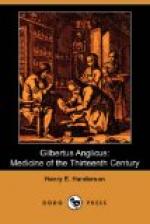Gilbert says: “Arthetica is a disease of the joints arising from a flux of humors descending into their continuity (concathenationem). The name is derived from the Latin artus, a joint, and the disease comprehends three species, viz., sciatica, disease of the scia, or the ligaments uniting the spine with the hip; cyragra, disease of the joints of the hands; and podagra, disease of the bones and joints of the foot, due to the descent of humors into their continuity. Sometimes, too, the disease affects other organs, occasioning pain in sensitive members, as, e.g., the head, and then derives its name from the part affected, as cephalea, emigranea or monopagia. Occasionally likewise some humor runs down (reumatizat) into the chest, spreading over the nerves of the breast or those of the spine between the vertebrae, and sometimes to other places. Hence the disease derives the general name gout (gutta), from its resemblance to a drop (gutta) trickling or falling downward and flowing over the weaker organs, which receive the humor. For gout arises particularly from rheumatic causes. Now, as the humors are rather uncontrollable (male terminabiles) fluids, they flow towards the exterior and softer parts, like the flesh and skin, which receive their moisture and being soft, dilatable and extensible, there results some swelling. But if the humors are hard and dry, they are confined within the interior of the organs, such as bones, nerves and membranes: and these, being hard in themselves, do not receive the moisture, nor suffer extension or dilatation, and thus no swelling results. Since, therefore, the material of this variety of arthetica, in which no swelling is present, is formed of grosser and harder substance and is found in the vicinity of hard and cold localities, it is dissolved slowly and the disease is not cured until this solution takes place. That form of the disease, however, in which there is swelling from a subtile and liquid material deposited in the soft parts is the more quickly cured. Hence swelling is the best sign of curability. This is most evidently true in podagra, unless the materies morbi, by reason of its scarcity, produces no enlargement of the affected part.”
Quoting the words of Rhazes, Gilbert tells us that the materies morbi of gout is, for the most part, crude and bloody phlegm. Rarely is it bilious, and still more rarely, melancholic. If, however, it is compounded, it consists chiefly of bile mixed with a subtile phlegm, and more rarely, of phlegm mixed with black bile (melancholia), occasionally of black bile mixed with blood. The mixture of black bile and blood or bile is very rare, and still rarer a mixture of all the humors according to their proportion in the body.




